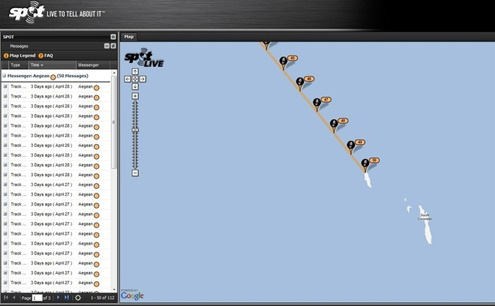US Sailing Releases Report on Newport to Ensenada Race Tragedy
PORTSMOUTH, R.I. (October 30, 2012) – US Sailing has released a report of an independent review panel on its investigation of the sailing accident that occurred on April 28 during the 2012 Newport to Ensenada Yacht Race that resulted in the deaths of four sailors. The crew were victims of an accident aboard Aegean, a 37-foot Hunter 376. The 125-mile Newport to Ensenada Yacht Race is held annually, starting from Newport Beach, Calif. and ending at Ensenada, Mexico. The Newport Ocean Sailing Association (NOSA) is the race organizer.

Aegean path - sailed straight into the island
Synopsis of Findings and Recommendations from the Report: The panel determined that a key element of the accident was likely an inadequate lookout*, and that it is likely that Aegean inadvertently motored beyond a waypoint set before North Coronado Island. Although the inadequate lookout was the proximal cause of the accident, there were additional safety issues that came to light during the inquiry, and improvements in these areas could prevent or reduce the severity of other accidents in the future.
The panel relied on available facts to create this report. There were no survivors and no eyewitnesses to the accident. The facts include the SPOT Connect (GPS tracking device with text capacity) position reports from which vessel course and speed were derived, times of SPOT Connect text transmissions during the race, published material, press reports including accounts of the San Diego Coroner’s report and the results of their toxicology analysis, interviews with race organizers, participants and past crew from Aegean, wreckage found at North Coronado Island and in the debris field and underwater at North Coronado Island.
The panel recommends improvements in the following areas:
- Always maintain a lookout, with a watch of at least two people, using audible waypoint and radar alarms.
- Racers need to be made aware of the light obscuration zones in the Coronado Islands.
- Each watch must understand the operation of the boat's navigation systems.
- The use of autopilots while motoring should be reviewed by race organizers.
- To improve communication, racers should monitor VHF 16 and race organizers should provide a 24-hour emergency contact.
- US Sailing should create a guide to emergency signaling devices.
- US Sailing should create a crisis management template for race organizers.
Read the entire US Sailing Report on the 2012 Newport to Ensenada Yacht Race. US Sailing will be making a presentation on the findings and recommendation at the Annual Meeting this Thursday, November 1 at the San Francisco Marriott Marquis in San Francisco, Calif. at 12:30 pm PT.
“The US Sailing Independent Review Panel members express our sorrow at the loss of four lives in this tragic accident,” said Bruce Brown, US Sailing Panel Chairman. “We offer our condolences to the family members of the victims. This accident was tragic and, we will not know what occurred during the last hours on board Aegean. The panel analyzed the facts and offers recommendations to the sailing community. My thanks go to the members of the panel for their diligent work, and to our sailing community who stepped forward to offer their insights into the events that occurred.”
The objective of this report is to reduce the chance of future similar tragedies by identifying the contributing factors leading up to this incident. This report is not intended to be used in any judicial proceedings whose purpose is to attribute or apportion liability or blame.
The members of the panel are Chairman Bruce Brown (Costa Mesa, Calif.), John Winder (Annisquam, Mass.), Alan Andrews (Corona del Mar, Calif.), Ed Adams (Middletown, R.I.), and Alan McMillan (Pensacola, Fla.). The Offshore Special Regulations Consultant on the panel is Evans Starzinger (Milford, Conn). The Safety at Sea Committee Chairman and Review Panel Liaison is Chuck Hawley (Santa Cruz, Calif.). The Medical Advisor was Dr. Steven Shea (Long Beach, Calif.). Jim Wildey (Annapolis, Md.) advised on investigation procedures and formats.
US Sailing is the national organizing body of the sport and is the overall authority for sanctioning sailboat races in the United States. US Sailing follows established policies of reviewing races involving causalities and/or fatalities. Similar reports from races include the 1979 Fastnet Race (Great Britain), 1988 Sydney Hobart Race (Australia) and the 2009 Flinders Islet Race (Cruising Yacht Club of Australia). In 2011, US Sailing independent panels reviewed three accidents beginning with a fatal incident involving a young girl in the Severn River (Severn Sailing Association); the fatal incident in the Chicago To Mackinac Race (WingNuts); and the near fatal accident in the Fastnet Race (Rambler 100). The reviews offer insight for race organizers and sailors of the facts involved in each of these events and offer suggestions to avoid and/or mitigate similar outcomes in the future.
In 2012, US Sailing was invited by the US Coast Guard to establish a panel to review the fatal accident during the Fully Crewed Farallon Island Race (Low Speed Chase) and in May of 2012, US Sailing created a panel to review this accident. In August of 2012, US Sailing released this report.
About US Sailing Safety Reports
For more information regarding US Sailing Safety Reports, visit us at http://offshore.ussailing.org/SAS/General_Information/Current_Safety_Studies.htm
*According to the International Maritime Organization, a lookout's task is to prevent collision. The International Regulations for Preventing Collisions at Sea (1972) Rule 5 says (in part): Every vessel must at all times keep a proper look-out by sight (day shape or lights by eyes or visual aids), hearing, and all available means in order to judge if risk of collision exists. According to the International Sailing Federation Case 26, all boats, whether or not holding the right of way, should keep a lookout at all times.
TOP
|